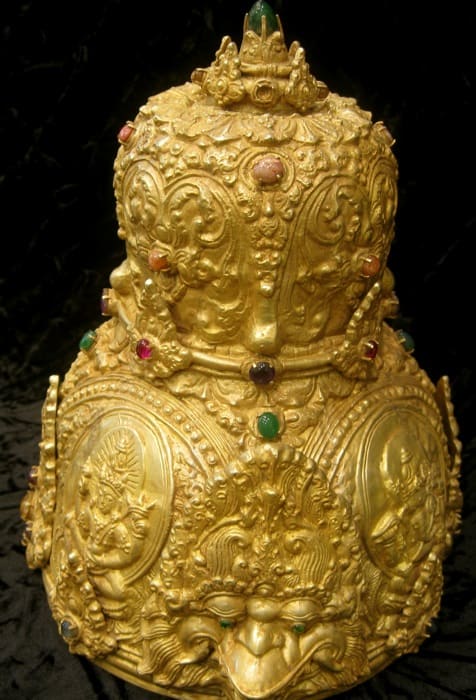Royal Gold Crown, 1300 CE - 1600 CE
Gold
height 24.8 cm
height 9 3/4 in
height 9 3/4 in
DV.030
This remarkable piece is a golden crown from the Indonesian archipelago. It is one of the most flamboyant such items that we have seen, the basic form is a double...
This remarkable piece is a golden crown from the Indonesian archipelago. It is one of the most flamboyant such items that we have seen, the basic form is a double dome, the lower about one and a half times the size of the upper. It is utterly covered with repousse relief work, with hosts of religious and decorative elements. The lower dome has a fantastical dragon-like face on the front, flanked by two medallions bearing images of religious figures (of the Hindu faith) surrounded by foliate scrollwork and organic motifs. The upper dome is decorated with repeated foliate scrolls and abstract decorations. The two domes are separated by a constriction marked with a high-relief band decorated with multi-coloured semi/precious stones in purple, green, red and blue. These are repeated around the base of the inferior dome and around the apex of the superior. The effect is breathtakingly opulent.
Indonesia has a long and complex royal and administrative history. This piece dates to the Majapahit kingdom, an Indianised kingdom based in Eastern Java, and ruling between the 12th and 16th centuries. It extended throughout Sumatra, Borneo and Eastern Indonesia as well as the Malay Peninsula, and is generally regarded as a Golden Age for Hindu empires in the Malay Archipelago.
Contemporary records – notably the Nagarakertagama (written in 1365) – reveal that the courts were highly sophisticated and refined. They encouraged artistic oeuvres, including writing and painting, and also attracted the finest minds in Eastern Asia to their extravagantly appointed palaces. It had considerable influence over neighbouring areas, although its power was more cultural than martial after the early stages, and the Majapahit monarchs were more concerned with monopolising trade through the archipelago. Geographical and economic constraints suggest that rather than a regular centralised authority, the outer states were most likely to have been connected mainly by trade connections, which was probably a royal monopoly. The kingdom was shaken by civil wars from 1405 to 1406, then again in the 1450s in another succession crisis. Family intrigue and competition from other Javanese power bases brought about the end of the empire in the early 16th century.
The Majapahit empire is noted for its extravagant art, architecture and other material profligacy. The capital – Trowulan – was renowned for its huge festivals and the elegant nature of its construction:
"Of all the buildings, none lack pillars, bearing fine carvings and coloured" [Within the wall compounds] "there were elegant pavilions roofed with aren fibre, like the scene in a painting... The petals of the katangga were sprinkled over the roofs for they had fallen in the wind. The roofs were like maidens with flowers arranged in their hair, delighting those who saw them".
Description of the Majapahit capital from the Old Javanese epic poem Nagarakertagama.
The king was a semi-divine personage in the eyes of his subjects; this piece of courtly regalia is an extremely important and rare object, and deserves pride of place in any discerning collection.
Indonesia has a long and complex royal and administrative history. This piece dates to the Majapahit kingdom, an Indianised kingdom based in Eastern Java, and ruling between the 12th and 16th centuries. It extended throughout Sumatra, Borneo and Eastern Indonesia as well as the Malay Peninsula, and is generally regarded as a Golden Age for Hindu empires in the Malay Archipelago.
Contemporary records – notably the Nagarakertagama (written in 1365) – reveal that the courts were highly sophisticated and refined. They encouraged artistic oeuvres, including writing and painting, and also attracted the finest minds in Eastern Asia to their extravagantly appointed palaces. It had considerable influence over neighbouring areas, although its power was more cultural than martial after the early stages, and the Majapahit monarchs were more concerned with monopolising trade through the archipelago. Geographical and economic constraints suggest that rather than a regular centralised authority, the outer states were most likely to have been connected mainly by trade connections, which was probably a royal monopoly. The kingdom was shaken by civil wars from 1405 to 1406, then again in the 1450s in another succession crisis. Family intrigue and competition from other Javanese power bases brought about the end of the empire in the early 16th century.
The Majapahit empire is noted for its extravagant art, architecture and other material profligacy. The capital – Trowulan – was renowned for its huge festivals and the elegant nature of its construction:
"Of all the buildings, none lack pillars, bearing fine carvings and coloured" [Within the wall compounds] "there were elegant pavilions roofed with aren fibre, like the scene in a painting... The petals of the katangga were sprinkled over the roofs for they had fallen in the wind. The roofs were like maidens with flowers arranged in their hair, delighting those who saw them".
Description of the Majapahit capital from the Old Javanese epic poem Nagarakertagama.
The king was a semi-divine personage in the eyes of his subjects; this piece of courtly regalia is an extremely important and rare object, and deserves pride of place in any discerning collection.
